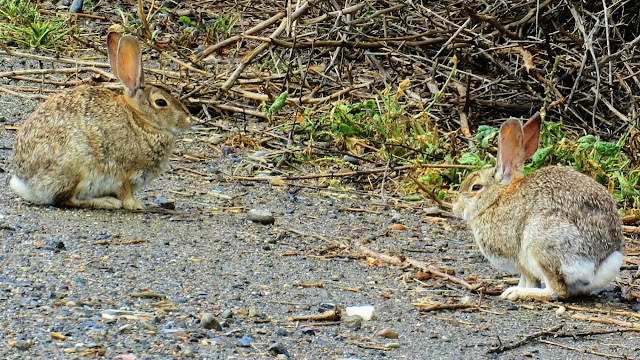Desert Cottontail Rabbits filmed in a variety of habitats. They have many threats and Coyotes and Hawks were sighted nearby. Not too unlike the eastern Cottontail, these rabbits tend to be very wary in desert scrub habitat and more communal and social where food is plentiful and deep cover is nearby as you will see in the video.
Filmed at Merced NWR and Mojave Desert in California.
The desert cottontail (Sylvilagus audubonii), also known as Audubon's cottontail, is a New World cottontail rabbit, and a member of the family Leporidae.
The desert cottontail is found throughout the western United States from eastern Montana to western Texas, and in northern and central Mexico. Westwards its range extends to central Nevada and southern California and Baja California.[2] It is found at heights of up to 2,000 m (6,600 ft). It is particularly associated with the dry near-desert grasslands of the American southwest; though it is also found in less arid habitats such as pinyon-juniper forest.
The desert cottontail is quite similar in appearance to the European rabbit, though its ears are larger and are more often carried erect. It is also social among its peers, often gathering in small groups to feed. The desert cottontail uses burrows made by rodents rather than making its own. Like all cottontail rabbits, the desert cottontail has a rounded tail with white fur on the underside which is visible as it runs away. It is a light grayish-brown in color, with almost white fur on the belly. Adults are 33 to 43 cm (13 to 17 in) long and weigh up to 1.5 kg (3.3 lb). The ears are 8 to 10 cm (3.1 to 3.9 in) long, and the hind feet are large, about 7.5 cm (3.0 in) in length). There is little sexual dimorphism, but females tend to be larger than the males, but have much smaller home ranges, about 4,000 square metres (1 acre) compared with about 60,000 square metres (15 acres) for a male.[3]
The desert cottontail is not usually active in the middle of the day, but it can be seen in the early morning or late afternoon. It mainly eats grass, but will eat many other plants, herbs, vegetables and even cacti. It rarely needs to drink, getting its water mostly from the plants it eats or from dew. Like most lagomorphs, it is coprophagic, re-ingesting and chewing its own feces: this allows more nutrition to be extracted.[3]
Many desert animals prey on cottontails, including birds of prey, mustelids, the coyote, the bobcat, the lynx, wolves, mountain lions, snakes, weasels, humans, and even squirrels, should a cottontail be a juvenile, injured or docile.[4] Southwestern Native Americans hunted them for meat but also used their fur and hides. The cottontail's normal anti-predator behavior is to run away in evasive zigzags; it can reach speeds of over 30 km/h (19 mph). Against small predators or other desert cottontails, it will defend itself by slapping with a front paw and nudging; usually preceded by a hop straight upwards as high as two feet when threatened or taken by surprise.[3]
The young are born in a shallow burrow or above ground, but they are helpless when born, and do not leave the nest until they are three weeks old. Where climate and food supply permit, females can produce several litters a year. Unlike the European rabbit, they do not form social burrow systems, but compared with some other leporids, they are extremely tolerant of other individuals in their vicinity.
https://en.wikipedia.org/wiki/Desert_cottontail
New HD videos uploaded frequently. Subscribe at:

No comments:
Post a Comment